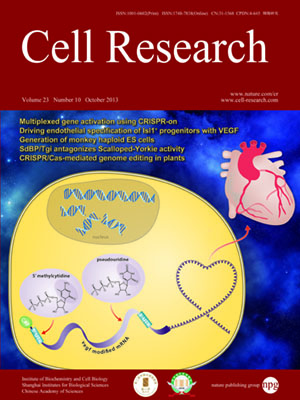
Volume 23, No 10, Oct 2013
ISSN: 1001-0602
EISSN: 1748-7838 2018
impact factor 17.848*
(Clarivate Analytics, 2019)
Volume 23 Issue 10, October 2013: 1187-1200
ORIGINAL ARTICLES
Generation of haploid embryonic stem cells from Macaca fascicularis monkey parthenotes
Hui Yang1,*, Zhen Liu2,*, Yu Ma3,*, Cuiqing Zhong1, Qi Yin1, Chikai Zhou1,4, Linyu Shi1, Yijun Cai2, Hanzhi Zhao3, Hui Wang5, Fan Tang3, Yan Wang2, Chenchen Zhang2, Xin-yuan Liu4, Dongmei Lai5, Ying Jin3, Qiang Sun2 and Jinsong Li1
1Group of Epigenetic Reprogramming, State Key Laboratory of Cell Biology, Shanghai Key Laboratory of Molecular Andrology, Institute of Biochemistry and Cell Biology, Shanghai Jiao Tong University School of Medicine, Shanghai Institutes for Biological Sciences, Chinese Academy of Sciences, Shanghai 200031, China
2Institute of Neuroscience, Shanghai Jiao Tong University School of Medicine, Shanghai Institutes for Biological Sciences, Chinese Academy of Sciences, Shanghai 200031, China
3Key Laboratory of Stem Cell Biology, Institute of Health Sciences, Shanghai Jiao Tong University School of Medicine, Shanghai Institutes for Biological Sciences, Chinese Academy of Sciences, Shanghai 200031, China
4College of Life Sciences, Zhejiang Sci-Tech University, Hangzhou, Zhejiang 310018, China
5The International Peace Maternity and Child Health Hospital, School of Medicine, Shanghai Jiao Tong University, Shanghai 200030, China
Correspondence: Jinsong Li, E-mail: jsli@sibcb.ac.cn; Qiang Sun, E-mail: qsun@ion.ac.cn; Ying Jin(yjin@sibs.ac.cn)
Recent success in the derivation of haploid embryonic stem cells (haESCs) from mouse via parthenogenesis and androgenesis has enabled genetic screening in mammalian cells and generation of gene-modified animals. However, whether haESCs can be derived from primates remains unknown. Here, we report the derivation of haESCs from parthenogenetic blastocysts of Macaca fascicularis monkeys. These cells, termed as PG-haESCs, are pluripotent and can differentiate to cells of three embryonic germ layers in vitro or in vivo. Interestingly, the haploidy of one monkey PG-haESC line (MPH1) is more stable compared with that of the other one (MPH2), as shown by the existence of haploid cells for more than 140 days without fluorescence-activated cell sorting (FACS) enrichment of haploid cells. Importantly, transgenic monkey PG-haESC lines can be generated by lentivirus- and piggyBac transposon-mediated gene transfer. Moreover, genetic screening is feasible in monkey PG-haESCs. Our results demonstrate that PG-haESCs can be generated from monkeys, providing an ideal tool for genetic analyses in primates.
10.1038/cr.2013.93
FULL TEXT | PDF
Browse 3151


